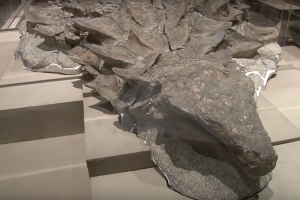 Because dinosaurs existed in pre-historic times, they seem to be a pigment of imagination brought to life in Hollywood films. Most fossils that were discovered were mainly composed of skeletons and bones. However, the Royal Tyrell Museum of Paleontology in Alberta Canada has a special treat for dinosaur enthusiasts and the public. It has recently unveiled a perfectly-preserved dinosaur fossil discovered in 2011, complete with armour, osteoderm and skin.
Because dinosaurs existed in pre-historic times, they seem to be a pigment of imagination brought to life in Hollywood films. Most fossils that were discovered were mainly composed of skeletons and bones. However, the Royal Tyrell Museum of Paleontology in Alberta Canada has a special treat for dinosaur enthusiasts and the public. It has recently unveiled a perfectly-preserved dinosaur fossil discovered in 2011, complete with armour, osteoderm and skin.
Unearthing of the Dinosaur Fossil
An oddly coloured fossil was discovered by heavy excavator operator Shawn Funk on 21st March 2011 at Millennium Mine. After the staff of the oil sands mine reported the discovery, paleontologists took over. They identified the dinosaur as a Nodosaur. Since the remains were well preserved, it looked unreal like something you would see from the Game of Thrones. To learn more about the discovered dinosaur, the museum partnered with the National Geographic Society.
According to researchers, this specific Nodosaur is a new species and a new genus. The fossil measures 18 feet and weighs around 2,500 pounds. Museum experts believe it is the oldest known dinosaur discovered in Alberta, Canada. In addition, it is the best preserved armoured dinosaur specimen ever found. The astonishing fossil has been featured in the June issue of the National Geographic magazine. According to them, the discovery is “as rare as winning the lottery.”
Preserved Dinosaur: The Nodosaur
Researchers spent three years and about 7,000 hours reconstructing the remains of the Nodosaur. This type of dinosaur existed 110 million years ago, which weighed around 3,000 pounds. The Nodosaur is described by the Smithsonian Natural History Museum as a four-legged herbivore with tank-like armor and 20-inch spikes.
The dinosaur is believed to have been swept away to sea by a flooded river. It looks too good to be true considering the number of years since dinosaurs became extinct. Researchers believe that the minerals in the sea helped preserve it to this state for millions of years. According to researcher Caleb Brown, “it was buried so quickly, nothing was able to scavenge the animal.” He thinks that there is a lot to be learned from the Nodosaur. The well preserved fossil offers a provocative window into the past.
A fossil of a similarly spiked dinosaur was recently identified at Canada’s Royal Ontario Museum. However, the remains are not as lifelike as the Nodosaur.
 English
English 中文
中文
